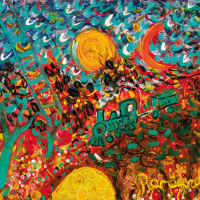88. JOHN PERCEVAL

John Perceval holds a significant place in Australian art history, as a member of both the Angry Penguins and the Antipodeans. His career is littered with accolades; most notably, winning The Wynne Prize in 1960 and being made an Officer of the Order of Australia in 1991 for service to the arts. Despite this success, Percevals life was bookended by unhappiness; a protracted period of artistic success lay between a turbulent childhood and a descent into alcoholism and mental illness in later life.
Perhaps the most fateful moment of Percevals life was when he befriended Arthur Boyd (1920-1999) at age eighteen, and subsequently moved into the Boyd family home in Murrumbeena. Here he found artistic and intellectual stimulation, connections to John and Sunday Reed and their inspired milieu, and romance with Boyds sister Mary, whom he married in 1944. Boyd and Perceval established the Arthur Merric Boyd Pottery in Murrumbeena where they produced earthenware ceramics throughout the late 1940s.1 Both artists tended to work in defined series, such as specific religious subjects or certain landscapes. For example, Boyd consistently returned to painting the Wimmera and Shoalhaven, while Perceval made the Melbourne suburbs of Williamstown and Bayswater his own.
Perceval first discovered Williamstown after acquiring a car in 1955 at age thirty-two. Located at the mouth of Melbournes Yarra River, Williamstown is a rambling port with shipyards, docks, piers, and a rocky shoreline punctuated by buoys and ship masts. Perceval is quoted as having said that finding Williamston, was like finding Venice.2 The original Williamstown landscapes formed Percevals first solo exhibition in 1956 at Australian Galleries. This exhibition also marked the opening of Australian Galleries by Tom and Anne Purves, a significant moment in the Australian art markets history.3 Following this moment of creative inception, Perceval would revisit the subject of Williamstown at various points throughout the ensuing decades (in the late 1950s, late 1960s, 1980s, and early 1990s), solidifying it as the subject with which he is most frequently associated. Margaret Plants description of Percevals Williamstown works reads as a fitting analysis of the present painting, Williamstown Ship: It is clear that the painter intends his audience to enjoy his painting, to respond to the warmth and blueness of the scene, to want to mess around in boats, to enjoy the vigour and spontaneity of the alla prima way of painting.'4
Perceval, like Boyd, was highly familiar with the stories of the Bible and regularly employed specific biblical symbols within his compositions. Despite the localised subject matter of Bayswater Train Colliding with a Goldmine, Perceval includes a depiction of Jacobs Ladder within the regional Victorian scene. The story of Jacobs Ladder from Genesis 28:10-21 refers to a prophetic dream in which Jacob sees a ladder stretching from heaven to earth, representing the connection between God and man. Here, the ladders evenly spaced rungs are reflected in the train tracks on the ground below. The ladder ascends into the sky, towards the heavens past both sun and moon, while the train tracks head into the depths of the goldmine, in this context, symbolic of hell.
Percevals landscapes, including the effervescent Williamstown Ship and Bayswater Train Colliding with a Goldmine, show a distinct admiration for Dutch post-impressionist painter, Vincent van Gogh (1853-1890). Percevals use of thick impasto and strong colours emanate from van Goghs style, resulting in similarly vibrant, kaleidoscopic scenes. These are among the most jubilant depictions of the Australian landscape, which is more often portrayed as vast and desolate. Art historian Traudi Allen commends Percevals exuberant landscapes for their, individualistic interpretation of impressionist colour techniques, [their] fauve patterning, and vigorous and seemingly careless brushstrokes, which together produce the often quoted sense of joie de vivre.5 The two present paintings epitomise this jubilant, dynamic style for which Perceval is most admired.
Footnotes:
1. Allen, T., John Perceval: Art and Life, Melbourne University Press, Melbourne, 2015, p.3
2. John Perceval, quoted in Plant, M., John Perceval, Lansdowne Press, Melbourne, 1971, p.52
3. Allen, T., op. cit., p.125
4. Plant, M., op. cit., p.52
5. Allen, T., John Perceval Painting and Poetry, in John Perceval: A Retrospective Exhibition of Paintings, Heide Museum of Modern Art, Melbourne, 1984, p.4
Asta Cameron